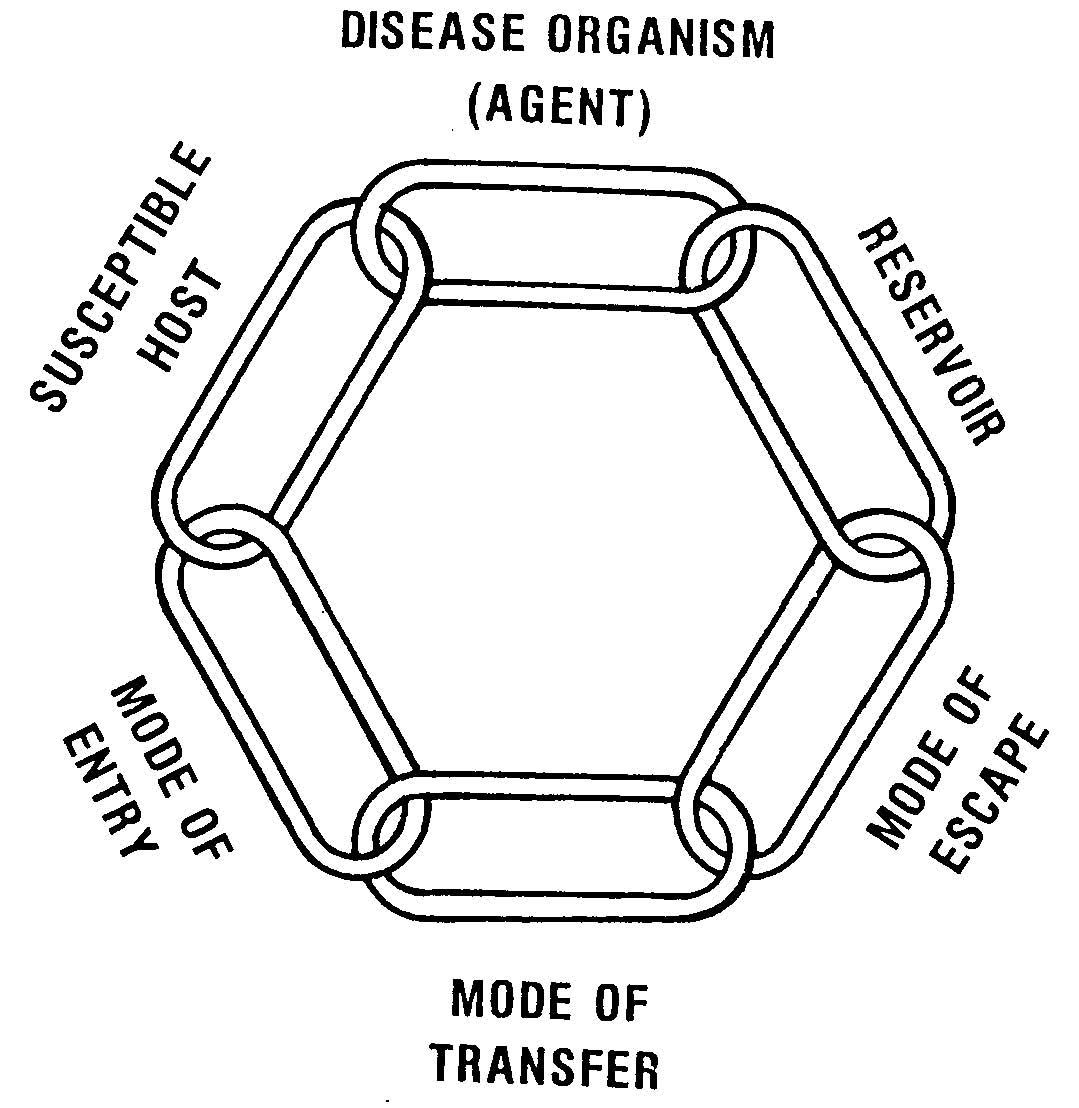Sterile Procedures
LESSON 1: Communicable Diseases
1-8
1-8. CYCLE OF INFECTION
Prevention and control of infection is of vital importance to the patient as well as to health care personnel. In order to provide proper care for patients with communicable diseases or infectious organisms, you should understand the components of infection and the methods to control the cycle of infection. The cycle of infection (see figure 1-1) is like a chain consisting of six links. To produce disease, each link of the infectious process must be present in a logical sequence. Removing one link in the chain will control the cycle of infection. The six links are discussed in the following paragraphs.
Figure 1-1. The cycle of infection.
a. Infectious Microorganisms (Agent). These are the pathogens that cause communicable diseases.
b. Reservoir. The reservoir (source) is the person or animal that has the disease. Sometimes a person may have a disease but is not ill. This type of person is called a carrier. The carrier known as Typhoid Mary is a classic example. She was a food worker in a restaurant who spread the disease typhoid by contaminating the foods she handled. Other examples of reservoirs are a person with a common cold, a person with malaria, a person with syphilis, a rat with plague, and a bat with rabies.
c. Mode of Escape. This refers to the route by which the infectious microorganisms escape the reservoir. For example, pathogens that cause respiratory diseases usually escape through the respiratory tract (coughing, sneezing, and so forth) Modes of escape and methods of controlling the mode (preventing the escape) are shown in figure 1-2.
|
MODES OF ESCAPE |
CONTROL |
|
Respiratory Tract. Microorganisms leave the body of the infected person by means of droplets exhaled as a spray in coughing, sneezing, talking, or just breathing. Microorganisms also escape in nose and throat secretions. |
(1) Wear a mask.
(2) Do not talk directly into patient's face.
(3) If you have an upper respiratory disease, such as a cold, do not work around patients.
|
|
Gastrointestinal Tract. Microorganisms that leave the body of the infected person by means of body secretions, for example, hepatitis, the virus is shed in the stool of the infected person.
|
(1) Handle body secretions properly.
(2) Perform patient care handwash.
|
|
Skin. Microorganisms that leave the body of the infected person by wound drainage or through skin lesions
|
(1) Dispose of wound dressings properly.
(2) Perform patient care handwash.
|
Figure 1-2. Modes of escape and their control.
d. Vector. The vector is the connection between the source of the disease (reservoir) and the person who is going to catch the disease (host). The vector is sometimes referred to as the "vehicle of disease transmission." Vectors and their control are discussed in figure 1-3.
|
VECTORS (MODES OF TRANSFER) |
CONTROL |
|
Contact (Direct Transfer). Physical contact with an infected person or items contaminated by an infected person, e.g., syphilis and wound drainage.
|
(1) Perform patient care handwash.
(2) Avoid direct contact with wound drainage.
(3) Wear a mask.
|
|
Indirect Contact (Airborne Transfer). Inhalation of droplets or dust particles contaminated with infectious agents from coughs and sneezes. |
Wear a mask. |
|
Insects. Transmittal of pathogens through arthropods such as flies, mosquitos, and ticks that bite infected persons causing such diseases as malaria and yellow fever.
|
Proper control of disease-carrying insects.
|
|
Food and Water. Through consumption of improperly cooked pork or poultry, contaminated raw fish, or water contaminated with feces, urine, or other infectious material.
|
Maintain high standards of--
(1) Mess sanitation.
(2) Water purification.
(3) Selection and preparation of food.
|
|
Fomites. These are articles contaminated with microorganisms from infected persons or animals. Some examples are surgical instruments, bed linen, and eating utensils.
|
(1) Wash linen.
(2) Use sterilized equipment for surgical procedures.
(3) Sanitize eating utensils.
|
Figure 1-3. Vectors and their control
e. Mode of Entry. The mode of entry refers to the method by which the pathogens enter the person (host). For example, some pathogens are inhaled (respiratory tract). Ways of controlling modes of entry are shown in figure 1-4.
|
MODES OF ENTRY |
CONTROL |
|
Respiratory Tract. Small residues (droplet nuclei) that result from evaporation of droplets from the respiratory tract of infected persons remain suspended in the air of poorly ventilated spaces for relatively long periods of time. The infectious microorganisms can be inhaled by a well person who may then become infected with the disease.
|
Wear a mask. |
|
Gastrointestinal Tract. Pathogenic microorganisms enter the body of new host when food or water contaminated by feces is ingested.
|
Dispose of body excretions carefully.
|
|
Skin. Pathogenic microorganisms enter the body when a person comes into contact with wound drainage or skin secretions.
|
Dispose of wound dressings carefully.
|
Figure 1-4. Modes of entry and their control.
f. Susceptible Host. The host is the person who gets the disease. Once the host has the disease, he becomes a reservoir for future transmission of the disease. A listing of the most susceptible persons to disease and some control measures are shown in figure 1-5.
|
SUSCEPTIBLE HOSTS |
CONTROL |
|
Children who are very young.
People who are very old.
People on inadequate diets.
People who are chronically ill.
People receiving medical therapy.
People who are already ill.
People with open wounds.
|
(1) Separate high risk persons from persons with known or potential infections.
(2) Provide nutritional supplements to persons on inadequate diets.
(3) Vaccinate against certain types of diseases.
(4) Maintain proper sanitation.
|
Figure 1-5. Susceptible hosts and control measures.


